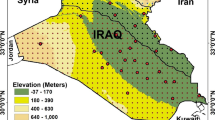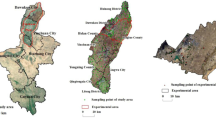Abstract
We have estimated soil moisture (SM) by using circular horizontal polarization backscattering coefficient (\(\sigma ^{\mathrm{o}}_{\mathrm{RH}}\)), differences of circular vertical and horizontal \(\sigma ^{\mathrm{o}} \, (\sigma ^{\mathrm{o}}_{\mathrm{RV}} {-} \sigma ^{\mathrm{o}}_{\mathrm{RH}})\) from FRS-1 data of Radar Imaging Satellite (RISAT-1) and surface roughness in terms of RMS height (\({\hbox {RMS}}_{\mathrm{height}}\)). We examined the performance of FRS-1 in retrieving SM under wheat crop at tillering stage. Results revealed that it is possible to develop a good semi-empirical model (SEM) to estimate SM of the upper soil layer using RISAT-1 SAR data rather than using existing empirical model based on only single parameter, i.e., \(\sigma ^{\mathrm{o}}\). Near surface SM measurements were related to \(\sigma ^{\mathrm{o}}_{\mathrm{RH}}\), \(\sigma ^{\mathrm{o}}_{\mathrm{RV}} {-} \sigma ^{\mathrm{o}}_{\mathrm{RH}}\) derived using 5.35 GHz (C-band) image of RISAT-1 and \({\hbox {RMS}}_{\mathrm{height}}\). The roughness component derived in terms of \({\hbox {RMS}}_{\mathrm{height}}\) showed a good positive correlation with \(\sigma ^{\mathrm{o}}_{\mathrm{RV}} {-} \sigma ^{\mathrm{o}}_{\mathrm{RH}} \, (R^{2} = 0.65)\). By considering all the major influencing factors (\(\sigma ^{\mathrm{o}}_{\mathrm{RH}}\), \(\sigma ^{\mathrm{o}}_{\mathrm{RV}} {-} \sigma ^{\mathrm{o}}_{\mathrm{RH}}\), and \({\hbox {RMS}}_{\mathrm{height}}\)), an SEM was developed where SM (volumetric) predicted values depend on \(\sigma ^{\mathrm{o}}_{\mathrm{RH}}\), \(\sigma ^{\mathrm{o}}_{\mathrm{RV}} {-} \sigma ^{\mathrm{o}}_{\mathrm{RH}}\), and \({\hbox {RMS}}_{\mathrm{height}}\). This SEM showed \(R^{2}\) of 0.87 and adjusted \(R^{2}\) of 0.85, multiple R=0.94 and with standard error of 0.05 at 95% confidence level. Validation of the SM derived from semi-empirical model with observed measurement (\({\hbox {SM}}_{\mathrm{Observed}}\)) showed root mean square error (RMSE) = 0.06, relative-RMSE (R-RMSE) = 0.18, mean absolute error (MAE) = 0.04, normalized RMSE (NRMSE) = 0.17, Nash–Sutcliffe efficiency (NSE) = 0.91 (\({\approx } 1\)), index of agreement (d) = 1, coefficient of determination \((R^{2}) = 0.87\), mean bias error (MBE) = 0.04, standard error of estimate (SEE) = 0.10, volume error (VE) = 0.15, variance of the distribution of differences \(({\hbox {S}}_{\mathrm{d}}^{2}) = 0.004\). The developed SEM showed better performance in estimating SM than Topp empirical model which is based only on \(\sigma ^{\mathrm{o}}\). By using the developed SEM, top soil SM can be estimated with low mean absolute percent error (MAPE) = 1.39 and can be used for operational applications.







Similar content being viewed by others
References
Aubert M, Baghdadi N, Zribi M, Douaoui A, Loumagne C, Baup F, Hajj M El and Garrigues S 2011 Analysis of TerraSAR-X data sensitivity to bare soil moisture, roughness, composition and soil crust; Remote Sens. Environ. 115 1801–1810.
Baghdadi N, Aubert M and Zribi M 2012 Use of TerraSAR-X data to retrieve soil moisture over bare soil agricultural fields; IEEE Geosci. Remote Sens. Lett. 9(3) 512–516.
Bala A, Rawat K S, Mishra A K and Srivastava A 2015 Assessment and validation of evapotranspiration using SEBAL algorithm and Lysimeter data of IARI Agricultural Farm, India; Geocarto Int. 31 1–29, https://doi.org/10.1080/10106049.2015.1076062.
Barrett B W, Dwyer E and Whelan P 2009 Soil moisture retrieval from active space borne microwave observations: An evaluation of current techniques; Remote Sens. 1(3) 210–242.
Blumberg D G, Freilikher V, Lyalko I V, Vulfson L D, Kotlyar A L, Shevchenko V N, and Ryabokonenko A D 2000 Soil moisture (water-content) assessment by an airborne scatterometer: The Chernobyl disaster area and the Negev desert; Remote Sens. Environ. 71 309–319.
Chen Q, Liu J, Tang Z, Zeng J and Li Y 2014 Study on the relationship between soil moisture and its dielectric constant obtained by space-borne microwave radiometers and scatterometers; 35th Int. Symp. Remote Sensing of Environment (ISRSE35), pp. 12–14.
DDMP (District Disaster Management Plan) Rewari 2013 Government of Haryana Department of revenue and Disaster Management, Haryana Institute of Public Administration, Plot 76, HIPA Complex, Sector 18, Gurgaon.
Dente L 2016 Microwave Remote Sensing for moisture mointoring synergy of active and passive observation and validation of retrieved products; Ph.D. thesis, Faculty of Geo-Information Science and Earth Observation, University of Twente.
Dobson M C and Ulaby F T 1981 Microwave backscatter dependence on surface roughness, soil moisture, and soil texture. Part III: Soil tension; IEEE Trans. Geosci. Remote Sens. 19 51–61.
Fung A K 1994 Microwave Scattering and Emission Models and their Applications; Artech House, Nordwood, USA.
Hallikainen M T, Ulaby F T, Dobson M C, El-rayes M A and Wu L K 1985 Microwave dielectric behavior of wet soil. 1: Empirical models and experimental observations; IEEE Trans. Geosci. Remote Sens. 23 25–34.
Hosseini R, Newlands N K, Dean B C and Takemura A 2015 Statistical modeling of soil moisture, integrating satellite remote-sensing (SAR) and ground-based data; Remote Sens. 7 2752–2780.
Kong X and Dorling S R 2008 Near-surface soil moisture retrieval from ASAR wide swath imagery using a principal component analysis; Int. J. Remote Sens. 29 2925–2942.
Liu C 2016 Analysis of Sentinel-1 SAR data for mapping standing water in the Twente region; PhD thesis, Faculty of Geo-Information Science and Earth observation, University of Twente.
Mironov V L, Dobson M C, Kaupp V H, Komarov S K and Kleshchenko V N 2004 Generalized refractive mixing dielectric model for moist soils; IEEE Geosci. Remote Sens. 42 773–785.
Neusch T and Sties M 1999 Application of the Dubois-model using experimental synthetic aperture radar data for the determination of soil moisture and surface roughness; ISPRS J. Photogramm. Remote Sens. 54(4) 273–278.
Nussberger M 2005 Soil moisture determination with TDR: Single-rod probes and profile reconstruction algorithms; PhD dissertation submitted to the Swiss Federal Institute of Technology ZURICH, Switzerland.
Rawat K S, Mishra A K, Sehgal V K, Ahmed N and Tripathi V K 2013 Comparative evaluation of horizontal accuracy of elevations of selected ground control points from ASTER and SRTM DEM with respect to CARTOSAT-1 DEM: A case study of Shahjahanpur (Uttar Pradesh), India; Geocarto Int. 28 439–452.
Rawat K S, Sehgal V K, Pradhan S and Ray S S 2017a Retrieval and validation of soil moisture from FRS-1 data set of radar imaging satellite (RISAT-1); Arab. J. Geosci. 10 445, https://doi.org/10.1007/s12517-017-3195-6.
Rawat K S, Bala A, Singh S K and Pal R K 2017b Quantification of wheat crop evapotranspiration and mapping: A case study from Bhiwani District of Haryana, India; Agr. Water Manag. 187 200–209.
Saleh A 1993 Soil roughness measurement: Chain method; J. Soil Water Conserv. 48CG 527–529.
Sikdar M and Cumming I 2004 A modified empirical model for soil moisture estimation in vegetated areas using SAR data; In: Geoscience and Remote Sensing Symposium 2004, IGARSS’04 Proceedings 2 803–806.
Singh D and Kathpalia A 2007 An efficient modeling with GA approach to retrieve soil texture, moisture and roughness from Ers-2 SAR data; Prog. Electromagn. Res. 77 121–136.
Srivastava H S, Patel P and Navalgund R R 2006 How far SAR has fulfilled its expectation for soil moisture retrieval? Microwave Remote Sensing of Atmosphere and Environment-II, AE107, Asia Pacific Remote Sensing Symposium, 12p.
Topp G C, Davis J L and Annan A P 1980 Electromagnetic determination of soil water content: Measurements in coaxial transmission lines; Water Resour. Res. 16(3) 574–582.
Ulaby F, Moore R K and Fung A K 1982 Microwave Remote Sensing: Active and Passive. Vol. II, Radar Remote Sensing and Surface Scattering and Emission Theory; Addison-Wesley, Advanced Book Program, Reading, Massachusetts, 609p.
Ulaby F T, Batlivala P P and Dobson M C 1978 Microwave backscatter dependence on surface roughness, soil moisture and soil texture. Part I: Bare soil; IEEE Trans. Geosci. Remote Sens. 16(4) 286–295.
Werrer J and Andreas K 2005 Soil surface roughness measurement-methods, applicability, and surface representation; Catena 64 174–192.
Zhang X, Chen B, Fan H, Huang J and Zhao H 2016 The potential use of multi-band SAR data for soil moisture retrieval over bare agricultural areas: Hebei, China; Remote Sens. 8(1) 1–14.
Zribi M and Dechambre M 2002 A new empirical model to retrieve soil moisture and roughness from C-band radar data; Remote Sens. Environ. 84 42–52.
Acknowledgements
FRS-1 data procured under RISAT-1 Utilization Programme of ISRO is gratefully acknowledged. The authors would like to express their gratitude to SAC, ISRO (India) for supplying the RISAT-1 (SAR) data for this project and also for the financial support. The authors would like to thank Mr. Manish Kumar, project staff and the farm field staff of Division of Agricultural Physics, IARI during field campaigns.
Author information
Authors and Affiliations
Corresponding author
Additional information
Corresponding editor: Prashant K Srivastava.
Supplementary material pertaining to this article is available on the Journal of Earth System Science website (http://www.ias.ac.in/Journals/Journal_of_Earth_System_Science).
Electronic supplementary material
Below is the link to the electronic supplementary material.
Rights and permissions
About this article
Cite this article
Rawat, K.S., Sehgal, V.K., Pradhan, S. et al. Semi-empirical model for retrieval of soil moisture using RISAT-1 C-Band SAR data over a sub-tropical semi-arid area of Rewari district, Haryana (India). J Earth Syst Sci 127, 18 (2018). https://doi.org/10.1007/s12040-018-0919-2
Received:
Revised:
Accepted:
Published:
DOI: https://doi.org/10.1007/s12040-018-0919-2




